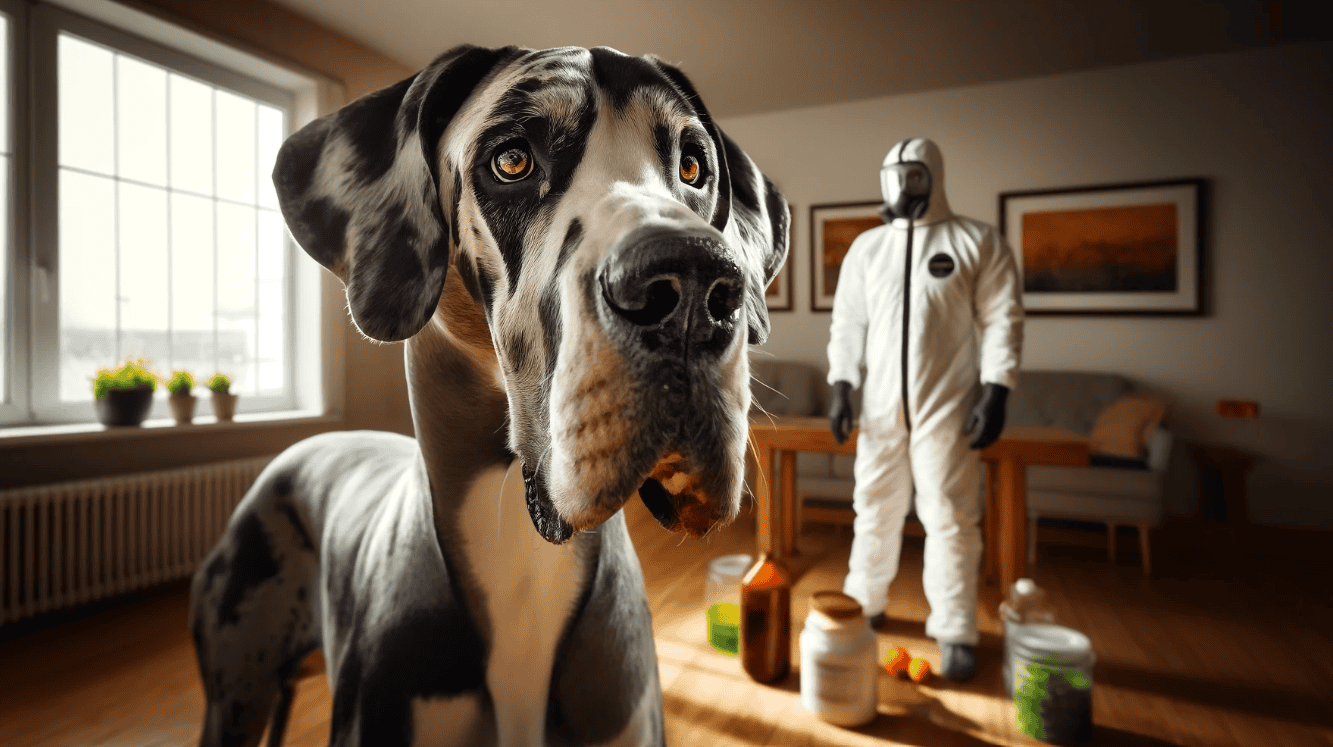As a holistic veterinarian, I understand the deep bond between you and your furry friend. But what happens when your beloved pet is diagnosed with sarcoptic mange? You might be wondering, “is sarcoptic mange contagious zoonotic?” In other words, can it jump from your dog to you? It’s a valid concern, and one that we’ll thoroughly explore. We’ll discuss what sarcoptic mange is, how it spreads, and most importantly, what you can do to protect both your four-legged companion and yourself.

If you’re a dog parent, the health of your furry friend is undoubtedly a top priority. But what happens when that health risk could potentially affect you too?
How Sarcoptic Mange Spreads Among Dogs
Sarcoptic mange, caused by the Sarcoptes scabiei mite, is highly contagious among dogs. The mites burrow into a dog’s skin, leading to intense itching and discomfort. These mites are easily transmitted from one dog to another through direct contact. It’s not just dogs who have the disease that are contagious – even dogs who have been treated can still pass on the mites until they are completely eradicated.
Factors Contributing to the Spread of Sarcoptic Mange
Several factors can contribute to the spread of sarcoptic mange. Overcrowding and poor hygiene in kennels or shelters can lead to an outbreak. Dogs with compromised immune systems are more susceptible, as their bodies may not be able to fight off the mites effectively. Additionally, the mites can survive in the environment for a few days, so your pet could potentially pick up sarcoptic mange from contaminated bedding or toys.
As a dog parent, it’s crucial to understand that sarcoptic mange is not a reflection of your pet’s cleanliness or your care. These mites can infect even the healthiest and best-cared-for dogs. The key is early detection and treatment to prevent further spread.
While sarcoptic mange primarily affects animals, it’s also important to note that the Sarcoptes scabiei mite can infect humans, leading to a condition known as scabies. This potential transmission from dogs to humans classifies sarcoptic mange as a zoonotic disease, which we’ll discuss in more detail in the next section.
Understanding the contagious nature of sarcoptic mange is the first step in protecting both you and your furry friend. Stay tuned as we dive deeper into the possibility of human transmission and how to safeguard against it.
Can Humans Get Sarcoptic Mange from Dogs?
As a veterinarian, I often get asked, “is sarcoptic mange contagious zoonotic?” The short answer is yes, it can be. Let’s break it down a little further to truly understand what this means.
Understanding Zoonotic Diseases
Zoonotic diseases are those that can be transmitted from animals to humans. They can be caused by different types of pathogens, including viruses, bacteria, fungi, and parasites. Sarcoptic mange falls under the category of parasitic zoonoses, which means it is caused by parasites – in this case, the Sarcoptes scabiei mite.
Key points:
- Zoonotic diseases can be transmitted from animals to humans.
- Sarcoptic mange is a type of zoonotic disease caused by the Sarcoptes scabiei mite.
The Possibility of Sarcoptic Mange Transmission from Dogs to Humans
Now, let’s tackle the question, “is sarcoptic mange contagious zoonotic?” The Sarcoptes scabiei mite that causes sarcoptic mange in dogs can indeed infect humans. However, it’s crucial to note that the mites prefer canine hosts. When they end up on human skin, they may cause a temporary skin reaction, but they cannot reproduce and sustain an infestation like they can in dogs.
That said, close contact with an infected dog can lead to a human developing symptoms such as itching and rash, which usually resolve once the mites are eliminated. So, while it is rare, it’s not impossible for humans to get sarcoptic mange from dogs.
Key points:
- The mites causing sarcoptic mange in dogs can infect humans, but they cannot reproduce on human skin.
- Close contact with an infected dog can lead to temporary symptoms in humans.
- While rare, it’s not impossible for humans to get sarcoptic mange from dogs.
Symptoms of Sarcoptic Mange in Humans
If you’re a dog owner, knowing the symptoms of sarcoptic mange in humans is crucial. This understanding can help you take prompt action if you or a family member start showing signs of this zoonotic disease.
Identifying Sarcoptic Mange Symptoms in Humans
The primary symptom of sarcoptic mange in humans is intense itching, especially at night. This is caused by the mites burrowing into the skin, leading to an allergic reaction. Other symptoms can include:
- Red rashes
- Small bumps or blisters
- Sores caused by scratching
- Skin thickening over time
These symptoms often appear on areas of the skin that came into direct contact with an infected dog. Common affected areas include the arms, chest, and waist. However, anyone experiencing these symptoms should seek medical attention, as these could also be signs of other skin conditions.
Differences between Human and Dog Sarcoptic Mange Symptoms
While the symptoms of sarcoptic mange in dogs and humans are similar, there are some notable differences. Dogs often experience hair loss, especially around the ears, elbows, and legs. They may also have crusty ear tips. Humans, on the other hand, do not experience hair loss as a symptom of sarcoptic mange. Also, the mites cannot complete their life cycle on human skin, meaning infestations in humans are typically short-lived, lasting only a couple of weeks.
Remember, is sarcoptic mange contagious zoonotic? Yes, it is. However, the manifestation of the disease varies between dogs and humans. As a dog parent, it’s essential to be aware of these symptoms and take necessary precautions to prevent transmission.
While it’s rare, humans can contract sarcoptic mange from their canine companions. Therefore, taking your dog for regular vet check-ups and keeping an eye out for symptoms in both your pet and your family is key to preventing this skin condition.

Preventing Sarcoptic Mange Transmission from Dogs to Humans
Precautionary Measures for Dog Owners
As a dog parent, it’s crucial to take certain steps to prevent the transmission of sarcoptic mange from your furry friend to you or your family. Here are some important precautions:
- Isolate Infected Dogs: If your dog is diagnosed with sarcoptic mange, it’s best to isolate them from other pets and humans in the household until they have been treated and are no longer contagious.
- Proper Hygiene: Regular hand washing, especially after handling your dog, can help reduce the risk of transmission. It’s also important to clean and disinfect your dog’s bedding, toys, and other items regularly.
- Protective Clothing: When handling a dog with sarcoptic mange, wear gloves and long sleeves to minimize skin contact. This can help prevent the mites from transferring to you.
- Regular Grooming: Regular grooming can help detect signs of mange early, making treatment more effective and reducing the risk of transmission.
Importance of Regular Vet Check-ups for Dogs
Regular veterinary check-ups are crucial in preventing sarcoptic mange transmission. These check-ups can help detect the presence of mites early, even before symptoms appear, allowing for prompt treatment.
Veterinarians can also provide valuable advice on preventative measures and treatments for sarcoptic mange. They can guide you on proper hygiene practices, recommend suitable products for cleaning and disinfecting your dog’s items, and suggest appropriate grooming routines.
Moreover, regular vaccinations and antiparasitic treatments can help keep your dog healthy and less susceptible to mites and other parasites. Remember, a healthy dog is less likely to contract sarcoptic mange, reducing the risk of transmission to humans.
Preventing is sarcoptic mange contagious zoonotic transmission is not just about protecting your health, but also ensuring the well-being of your beloved pet. By following these precautions and ensuring regular vet check-ups, you can enjoy a healthy and happy life with your furry friend.
Treatment for Sarcoptic Mange in Dogs
If you’re a dog parent dealing with a case of sarcoptic mange, firstly, know that you’re not alone. This skin condition is quite common and, luckily, treatable. The first step in treating sarcoptic mange is to consult with your veterinarian. They will be able to provide an accurate diagnosis and guide you on the best course of action.
Common Treatments for Sarcoptic Mange in Dogs
There are several treatment options available for sarcoptic mange in dogs. Here are a few common ones:
- Topical treatments: These include medicated shampoos, ointments, and creams that can help to kill the mites causing the mange. These treatments can soothe the skin and help to reduce itching and inflammation.
- Oral medications: In some cases, your vet may prescribe oral medications to kill the mites. These medications are typically given for a few weeks until the mites are fully eliminated.
- Injectable medications: For severe cases, injectable medications may be used. These are administered by your vet and can quickly kill the mites and alleviate symptoms.
Remember, each dog is unique and the best treatment option will depend on your dog’s specific condition, overall health, and response to treatment.
The Role of Vets in Treating Sarcoptic Mange
Your vet plays a crucial role in the successful treatment of sarcoptic mange. Not only can they provide the right diagnosis and treatment plan, but they can also monitor your dog’s progress and adjust the treatment if necessary. They can provide advice on how to prevent future infestations and ensure that your dog is back to its happy, healthy self in no time.
Moreover, vets can also provide valuable advice on how to prevent the spread of this contagious zoonotic disease to humans or other animals in the house. They can guide you on the necessary precautions to take and how to keep everyone in the home safe.
In short, while dealing with sarcoptic mange can be stressful, remember that there is effective treatment available. With the right care and guidance from your vet, your furry friend can recover fully and go back to enjoying their regular activities.

Medical Treatments for Humans Affected by Sarcoptic Mange
If you find yourself with symptoms of sarcoptic mange, it’s essential to seek medical attention promptly. Remember, early treatment can prevent complications and further spread of the condition.
Most doctors will prescribe a scabicide, a medication that kills the Sarcoptes scabiei mites causing the condition. Commonly prescribed scabicides include Permethrin cream, Lindane lotion, and Ivermectin. These treatments are typically applied to the skin and left on for several hours before being washed off.
It’s important to note that even after successful treatment, itching can persist for a few weeks. This is due to the body’s response to mite debris, not a sign of ongoing infestation. Antihistamines or corticosteroid creams may be recommended to alleviate this post-treatment itching.
Home Remedies and Prevention for Sarcoptic Mange in Humans
While medical treatment is vital, there are also steps you can take at home to aid recovery and prevent future infestations.
- Hygiene: Regularly washing your clothes, bedding, and towels can help eliminate mites. It’s also recommended to vacuum regularly to prevent mites from settling in your home.
- Soothing the skin: Oatmeal baths and aloe vera can help soothe itching and inflammation caused by sarcoptic mange. However, these should be used in addition to, not instead of, prescribed treatments.
- Preventing re-infestation: If your dog has been diagnosed with sarcoptic mange, ensure they complete their treatment and avoid close contact until they’re no longer contagious.
Remember, sarcoptic mange is a zoonotic disease, meaning it can pass from pets to humans. So, if your furry friend is scratching more than usual or showing signs of skin irritation, it’s best to get them checked by a vet. That way, you can catch any potential issue early, protecting both your pet and your family from sarcoptic mange.
The Impact of Sarcoptic Mange on Human-Dog Relationships
Understanding that is sarcoptic mange contagious zoonotic can understandably cause anxiety and fear among dog parents. Yet, it’s important to remember that while this condition can be uncomfortable and distressing, it’s also manageable and treatable.
Managing Fear and Anxiety Related to Sarcoptic Mange
Firstly, it’s crucial to manage any fear or anxiety you may have about your furry friend’s condition. Remember, your dog needs your support and love now more than ever. While it’s natural to worry about the possibility of catching sarcoptic mange from your dog, know that with the right precautions, the risk can be significantly minimized.
The Importance of Education and Awareness about Sarcoptic Mange
Education is your most powerful tool in this situation. By understanding the nature of sarcoptic mange, its symptoms in both dogs and humans, and how it spreads, you can take effective steps to prevent transmission. Regular vet check-ups for your dog, proper hygiene practices, and prompt treatment if symptoms appear are all crucial.
Moreover, it’s important to spread awareness about sarcoptic mange and its zoonotic nature. By sharing accurate information, we can collectively reduce the stigma often associated with this condition and ensure that affected dogs and their human families receive the support they need.
Remember, while sarcoptic mange can be a challenging experience for both you and your dog, it doesn’t have to affect the bond you share. With understanding, care, and appropriate treatment, your dog can recover fully, and life can return to normal. Let’s continue to foster a world where our relationships with our pets are defined by love and understanding, not by fear of diseases.
Frequently Asked Questions
Q1: Can humans contract Sarcoptic Mange from dogs?
A: Yes, humans can contract a temporary form of Sarcoptic Mange from dogs. However, the mite that causes the disease in dogs cannot reproduce on human skin, so the infestation in humans is self-limiting and will resolve on its own over time.
Q2: What are the symptoms of Sarcoptic Mange in humans?
A: In humans, Sarcoptic Mange typically causes a rash and intense itching, particularly at night. The rash may appear as red bumps, similar to mosquito bites, and is often located on the wrists, elbows, or any area of skin that was in direct contact with the infested dog.
Q3: How can I prevent getting Sarcoptic Mange from my dog?
A: The best way to prevent getting Sarcoptic Mange from your dog is to treat the dog promptly if it becomes infested. Regularly grooming your dog and keeping its living area clean can also help prevent the mites from spreading.
Q4: How is Sarcoptic Mange treated in dogs?
A: Sarcoptic Mange in dogs is typically treated with a combination of medicated shampoos and dips, oral medications, and injectable drugs. It’s important to follow your vet’s instructions carefully, as treatment must be thorough to ensure all mites are killed.
Q5: Can Sarcoptic Mange be fatal to dogs?
A: If left untreated, Sarcoptic Mange can cause severe skin infections, loss of appetite, and severe itching that can lead to self-inflicted wounds. In extreme cases, it can be fatal. However, with prompt and proper treatment, most dogs recover fully.
